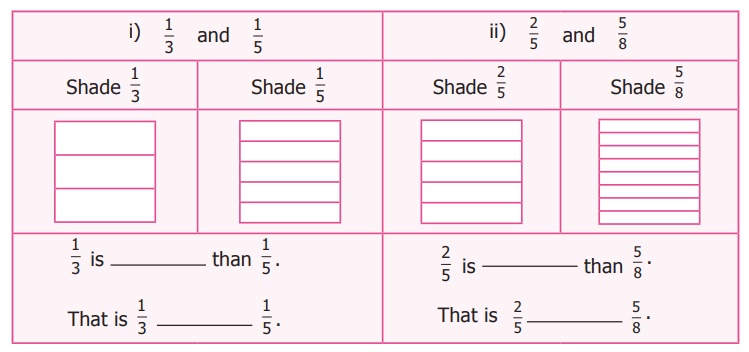Fractions | Term 3 Chapter 1 | 6th Maths - Comparison of Unlike Fractions | 6th Maths : Term 3 Unit 1 : Fractions
Chapter: 6th Maths : Term 3 Unit 1 : Fractions
Comparison of Unlike Fractions
Comparison
of Unlike Fractions
Think about the situation 1
Murugan has scored 7/10
in Science and 9/10 in Mathematics test. In which subject he has performed better?
It is quite easy to say his performance is better in Mathematics.
But can you find, the
better performance of Murugan between the two test scores such as 9/10 and 13/20
in Mathematics. We need to convert both the marks as like fractions.
The equivalent fraction of 9/10 is 18/20. Now we can compare the first test score with that
of the second test score because both the scores are out of 20 marks. Here 18 >
13. So, 18/20 > 13/20 . Thus, Murugan has performed better in the first test.
Think about the situation 2
In a Hockey tournament,
Team A played 6 matches and won 5 matches out of it. Team B played 5 matches and
won 4 matches out of it. If both the teams performed consistently in this way, find
out which team will win the tournament?
From these we need to
see which is greater 5/6 or 4/5? How can we find this? The total number of matches
played by each team differs. By finding the equivalent fractions of 5/6 and 4/5,
we can equalize the number of matches played by team A and team B.
5/6 = 10/12 = 15/18 =
20/24 = 25/30
4/5 = 8/10= 12/15 = 20/25
= 24/30

Note that the common denominator
of equivalent fraction is 30, which is 5 × 6.
It is the common multiple
of both 5 and 6.
Here 25/30 > 24/30 . So Team A will win the
game.
Note
To compare two or more unlike fractions,
we have to convert them into 'like fractions'. These 'like fractions' are the equivalent
fractions of the given fractions. The denominator of the 'like fractions' is the
Least Common Multiple (LCM) of the denominators of the given unlike fractions.
Example 2
Madhu ate 2/5 of the chocolate
bar and Nandhini ate 1/3 of the chocolate bar. Who has eaten more?
Solution
The portion of the chocolate
eaten by Madhu = 2/5
The portion of the chocolate
eaten by Nandhini = 1/3
Here the portions of the
chocolates eaten by both differ.
To make it same, their
equivalent fractions are to be found.
Finding the equivalent
fractions of 2/5 and 1/3 having common denominators
are the same as finding the least common multiple of the denominators of the given
fractions.
Hence 2/5 = [2 × 3] /
[5 × 3] = 6/15 and 1/3 = [1 × 5] / [3 × 5] = 5/15 So, 6/15 > 5 /15
Therefore, we can conclude that Madhu has eaten
more chocolates.
Note
The process of finding the like fractions
of the given unlike fractions can be made easier by finding the common multiples
of the denominators of the unlike fractions.
Example 3
Vinotha, Mugilarasi, Senthamizh were participating in
the water filling competition. Each one was given a bottle of equal volume to fill
water in it within 30 seconds. If Vinotha filled 1/2 portion of her bottle, Senthamizh
filled 3/4 portion of her bottle and Mugilarasi filled 1/4 portion of her bottle,
then who would get the first, second and third prize?
Solution
The equivalent fractions
need to be written until the denominator becomes 4 which is the LCM of 2 and 4.
Equivalent fraction of
1/2 is 2/4

Here 1/4 < 2/4 < 3/4 . Therefore, Senthamizh would get the
first prize, Vinotha would get the second prize and Mugilarasi would get the third
prize.
Example 4
Arrange 2/3 , 1/6 , 4/9 in ascending order.
Solution
Equivalent fractions of
2/3 are 4/6, 4/6, 6/9, 8/12, 10/15, 12/18, ….
Equivalent fractions
of 1/6 are 2/12, 3/18,..
Equivalent fraction of
4/9 is 8/18,…
Therefore 3/18 <
8/18 < 12/18
The ascending order of
given fractions is 1/6, 4/9 , 2/3.
Comparison of Unit Fractions: Unit fractions are fractions having 1 as its numerator. For example compare
1/7 and 1/5 . One can conclude that
1/5 > 1/7 by observing the diagram. So, in unit fraction the larger the denominator the smaller will be
the fraction. Hence, we conclude that if the numerators are the same in two fractions,
the fraction with the smaller denominator is greater of the two.

Try these
1. Shade the rectangle for the given
pair of fractions and say which is greater among them.


2. Which is greater 3/8 or 3/5?
3/5 is greater
3. Arrange the fractions in ascending
order: 3/5, 9/10 , 11/15
3/5, 11/15, 9/10
4. Arrange the fractions in descending
order: 9/20, 3/4 , 7/12
3/4, 7/12, 9/20
Related Topics